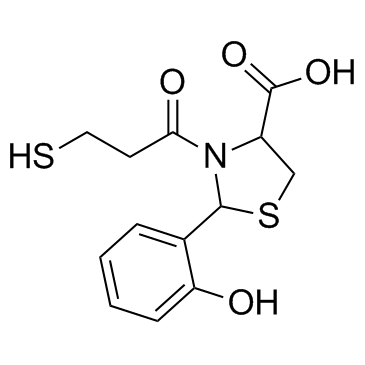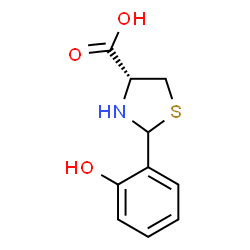Rentiapril racemate

Rentiapril racemate structure
|
Common Name | Rentiapril racemate | ||
|---|---|---|---|---|
| CAS Number | 72679-47-1 | Molecular Weight | 313.39300 | |
| Density | 1.451g/cm3 | Boiling Point | 553.7ºC at 760 mmHg | |
| Molecular Formula | C13H15NO4S2 | Melting Point | N/A | |
| MSDS | N/A | Flash Point | 288.7ºC | |
Use of Rentiapril racemateRentiapril racemate is the racemate of Rentiapril. Rentiapril is an angiotensin converting enzyme (ACE) inhibitor. |
| Name | 2-(2-hydroxyphenyl)-3-(3-sulfanylpropanoyl)-1,3-thiazolidine-4-carboxylic acid |
|---|---|
| Synonym | More Synonyms |
| Description | Rentiapril racemate is the racemate of Rentiapril. Rentiapril is an angiotensin converting enzyme (ACE) inhibitor. |
|---|---|
| Related Catalog | |
| Target |
angiotensin converting enzyme (ACE)[1] |
| In Vivo | A three-months toxicity study of an angiotensin converting enzyme (ACE) inhibitor, Rentiapril (CAS 80830-42-8), is performed in Sprague-Dawley rats by oral administration. The dose levels of 0, 30, 125, 500 and 1000 mg/kg are tested in both sexes, in which each experimental group comprised 10 rats. Another ACE inhibitor, captopril, is used as a reference compound. Rentiapril at the highest dose of 1000 mg/kg causes low food consumption and death of some animals with signs of bloody feces and anemia. In males and females receiving 500 and 1000 mg/kg, there are low body weight gain, increases in water intake, urine volume and serum BUN level, and decreases in levels of various erythrocytic parameters. Kidney weight is increased dose-dependently in both sexes. Histopathologically, renal changes in the 500 and 1000 mg/kg groups consist of proximal tubular degeneration, juxtaglomerular cell hyperplasia and interstitial cell infiltration. Similar, but mild, changes in proximal tubules are present in the female 125 mg/kg group. Dead animals from the highest dose groups further show gastrointestinal hemorrhagic erosion and/or ulcer, decrease bone marrow erythropoiesis and hepatocytic vacuolar degeneration. There is no pathological alteration in rats from other Rentiapril-treated groups, as well as in controls. These results indicate that the no-effect dose of Rentiapril in rats by three months oral administration is 30 mg/kg in female and 125 mg/kg in male[1]. |
| References |
| Density | 1.451g/cm3 |
|---|---|
| Boiling Point | 553.7ºC at 760 mmHg |
| Molecular Formula | C13H15NO4S2 |
| Molecular Weight | 313.39300 |
| Flash Point | 288.7ºC |
| Exact Mass | 313.04400 |
| PSA | 141.94000 |
| LogP | 1.67720 |
| Index of Refraction | 1.66 |
|
~81% 
Rentiapril racemate CAS#:72679-47-1 |
| Literature: Oya; Baba; Kato; Kawashima; Watanabe Chemical and Pharmaceutical Bulletin, 1982 , vol. 30, # 2 p. 440 - 461 |
|
~% 
Rentiapril racemate CAS#:72679-47-1 |
| Literature: Oya; Baba; Kato; Kawashima; Watanabe Chemical and Pharmaceutical Bulletin, 1982 , vol. 30, # 2 p. 440 - 461 |
| Precursor 1 | |
|---|---|
| DownStream 0 | |
| 2-(2'-Hydroxyphenyl)-3-(3-mercaptopropanoyl)-4-thiazolidine carboxylic acid |
| (4R)-2-(2-hydroxyphenyl)-3-(3-mercaptopropanoyl)-4-thiazolidinecarboxylic acid |
| 4-Thiazolidinecarboxylic acid,2-(2-hydroxyphenyl)-3-(3-mercapto-1-oxopropyl) |
| SA 446 |
| C13H15NO4S2 |
| Rentiapril racemate |

